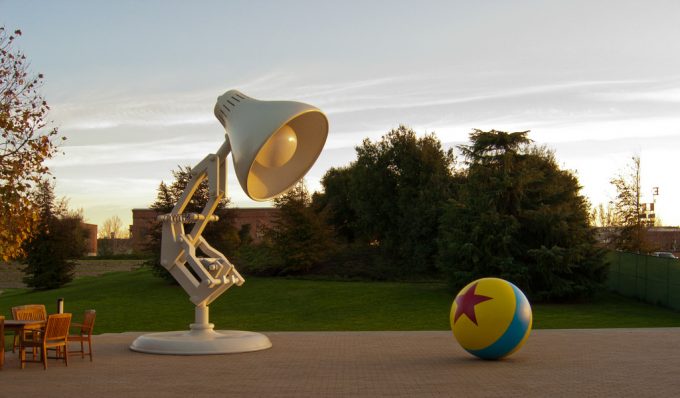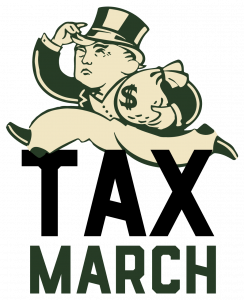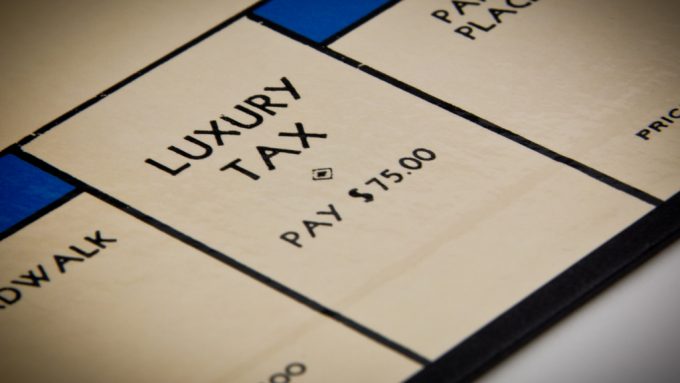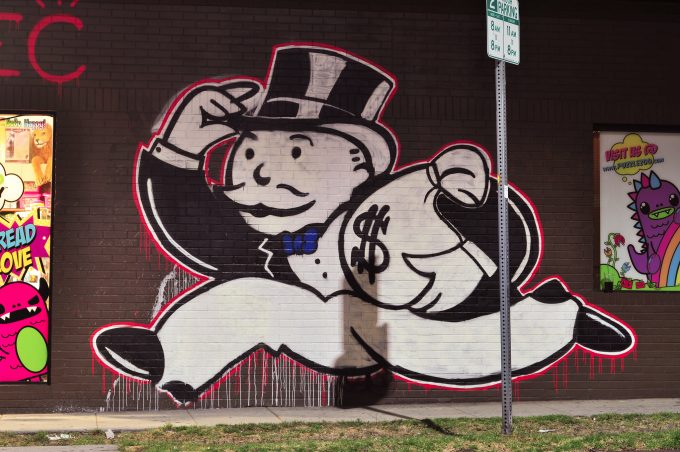
This work is a derivative of “Change” by Damian Gadal, used under CC BY. It is licensed under CC BY by ThinkDesign Group.
Chump Change
In truth, poverty is an anomaly to rich people. It is very difficult to make out why people who want dinner do not ring the bell.
– Walter Bagehot
If Trump University weren’t defunct, I’d suggest it offer a course on the “Trumpian theory of value.” That’s because I think Donald Trump offers a novel and rather imaginative perspective on the worth of things (like, for example, his many resplendent golf courses). Value, he and his phalanx of lawyers contend, is not fixed. Rather, it’s relative. It varies according to who’s asking.
Take the Trump National Golf Club Jupiter in Jupiter, Florida. Trump was said to value it at more than $50 million, a tidy sum for any mogul. And yet his attorney argued in court for three straight years—much to the chagrin of Palm Beach County officials—that it was worth no more than $5 million. A lower value means a smaller tax assessment.
Another strategy is to find deductions everywhere. To qualify for a New Jersey farmland tax break, Trump raises goats on his golf course in Bedminster. As government and legal records show, Trump took so many deductions that he paid nothing in federal income taxes for at least five years between 1970s and 1990s.
You might call this creative accounting or employ some other hard-hearted sardonic quip. But I think there’s something more profound, more philosophical at play than mean material interest. Plato talked about the intrinsic and instrumental value of things. Something with intrinsic value is sufficient unto itself (like art or pleasure). Instrumental value (think, money) has to do with what something can be used or exchanged for. Trump elides these distinctions.
“When you’re talking about properties that are owned by Mr. Trump, there is an intrinsic value associated with those properties because he is associated or owns those properties,” a Trump representative said. “There’s never been anyone like Mr. Trump, with his net worth, to run for the highest office in the land.” Or as Trump himself put it, “My net worth fluctuates, and it goes up and down with markets and with attitudes and with feelings, even my own feelings.”
Trump, you see, is an aesthete, a lover of the good life and supposedly fine things. The tax collector, on the other hand, is a mean charlatan, ravenously digging in couches for even the smallest change. To measure one of Trump’s 12 golf courses instrumentally is to degrade it. And so he has his accountants stamp “paid under protest and without prejudice” on his tax forms each year.
It’s for the same reasons that Trump is suing the small town of Ossining, New York, home of the Trump National Golf Club Westchester. CNN reports that the assessed property value of the course is $15.1 million, rather higher than Trump’s valuation of $1.5 million. If Ossining gets its way, the tax bill on the course will be around $500,000. If the court decides in Trump’s favor, he’ll get a refund of about $450,000. The town assessor says, with great temerity, that the refund would put “a huge strain” on the school district, which depends on taxes for the majority of its budget. It would fall to others, those less canny than the President, “to pick up the difference.”
The following essays deal, in one way or another, with tax shortfalls and who picks up the slack. Laura Blessing explains how the GOP became the party of tax cuts and forecasts exploding deficits resulting from the runaway reductions proposed by the current regi-, er… administration. Unless, that is, someone (Mexico?) can be made to pay for them.
The obverse—that the Democratic Party came to be viewed as the party of tax hikes—needn’t have been the case, writes Joshua McCabe, had Democrats been smarter about offering working- and middle-class families tax relief after the 1973 oil crisis. Inflation-led bracket creep meant that ordinary families ended up paying more, and the Republicans were quick to capitalize on their disaffection.
Such “taxation by stealth” did much to make Americans suspicious of government. But as Isaac William Martin writes, they may not be as anti-tax as we might suppose, particularly when they know what their money is paying for. Looking at California, Martin has found that citizens regularly vote for tax increases. Perhaps transparency in taxation might be the best way forward.
Some of the taxes states and cities use to try to make up for revenue shortfalls are local sales taxes. However, this strategy only entrenches inequalities by fueling competition between municipalities, argues Josh Pacewicz. Moreover, it distorts policy priorities as city managers feverishly chase taxable commercial revenues. And, as Vanessa Williamson writes, Americans misunderstand the sales tax system, mistaking flat and national sales taxes for progressive proposals, when they are anything but. While the rich might buy more big-ticket items, it’s the poor and working class that spend the bulk of their income on daily necessities and bear the greater burden.
Lastly, Monica Prasad exposes an even darker consequence of the continual drive to cut taxes: police brutality. Starved of reliable revenue streams, local governments and police departments turn to fees and fines to fund city services. Officers are pressured to crack down on small issues, aggressively enforcing rules around jaywalking, for instance, and to seize property from those they stop. In turn, police-community relations are polluted and more-frequent encounters are more frequently deadly.
— Shehzad Nadeem
- Sales Taxes and Municipal Fiscal Inequality,
by Josh Pacewicz - Why Do Americans Hate Taxes?,
by Joshua McCabe - The Only Trump Pivat That Mattered,
by Laura Blessing - Mistaking Regressive for Progressive Taxes,
by Vanessa Williamson - The Great California Experiment,
by Isaac William Martin - Deadly Deficits,
by Monica Prasad
Sales Taxes and Municipal Fiscal Inequality
by Josh Pacewicz
We’ve all heard that sales taxes are regressive, representing a greater burden on those with lower incomes. But there’s a key way in which they promote inequality that’s often overlooked: by reflecting and entrenching fiscal imbalances between municipalities. Particularly in states wherein municipalities face property tax restrictions or the state government has scaled back redistributive revenue sharing, policy-makers have empowered municipalities to charge local sales taxes in addition to those collected by the state. This sounds like a win-win: it costs the state little and gives municipalities an option to collect additional revenue. In reality, such policies encourage municipalities to compete for commercial investment and aggravate fiscal inequalities between rich and poor, and White-, Brown- and Black- majority suburbs and cities.

California is an extreme exemplar of inter-municipal inequalities. Since the 1950s, the state has allowed municipalities to collect sales tax revenue via the Bradley-Burns tax. This revenue has become particularly important to municipal budgets since Proposition 13 (which lowered property tax rates in the late 1970s). Indeed, according to a survey by the Public Policy Institute, the state’s city managers cited ability to generate sales tax revenue as their top consideration when considering a new development, ahead of considerations like consistency with their city’s comprehensive plan, potential for generating new jobs, aesthetics, and so on. According to Basketball Insiders, particularly because of the state’s long history with Tax Increment Financing—which allows city leaders to divert property taxes into special funds that often become slush funds for city governments—inter-municipal competition was fierce. Some cities captured a large proportion of their property taxes via TIF and used the moneys to attract commercial investment, while others, left to rely on insufficient property tax revenue, entered a permanent phase of fiscal crisis.
At one extreme, Emeryville, sandwiched between Berkeley and Oakland, successfully attracted commercial investment and became a retail hub at the expense of its two neighbors, largely by leveraging most of its tax base. At the other extreme, Black and Brown Bay Area suburbs like Stockton and Antioch were unable to attract commercial investment. Defying paradigmatic sociological classics like growth machine theory, they grew many times over with an influx of predominantly low-income migrants, but—because of property tax caps—have seen their fiscal situations deteriorate. They teetered on the brink of bankruptcy after the 2007-8 financial crisis and have since become “slum-burbs,” unable to provide adequate services for their residents.
Illinois offers an even starker example of how municipalities’ reliance on sales taxes can aggravate racial inequalities. As you might expect, fiscal inequalities between Chicago suburbs tend to run White-Black, but seem to persist even between municipalities with similar income profiles. Consider tiny Olympia Fields, a south-side Chicago suburb that bills itself as one of the most educated and affluent Black communities in the U.S. (average family income is $101,000). Despite this income profile, the city relies heavily on non-tax revenues (notably, fines and forfeits) and collects high property taxes. Indeed, the effective property tax rate in the city is 4.6%, which means that the owner of a median priced home with a 30-year mortgage at today’s interest rates pays nearly as much in property taxes as in interest and principal ($855 monthly in taxes as compared to a $1,129 mortgage payment). In comparable White-majority suburbs, effective property tax rates are roughly half those in suburbs like Olympia Fields.
While the historical causes of these fiscal inequalities in Illinois are uncertain, community leaders and anecdotal evidence suggest that unequal access to sales tax revenue plays a huge role. The key is found in the broader patterns of racial segregation in Chicagoland. Upper-income White suburbs are clustered in a band between middle-income White suburbs closer to the North and Northwest border of Chicago and hyper-wealthy White suburbs just beyond. By contrast, upper-income Black suburbs are surrounded by dramatically poorer municipalities, some of which have suffered an outright fiscal collapse. For instance, Olympia Fields is just a few miles from Ford Heights, by some measures the poorest suburb in the U.S., which was recently forced to eliminate its police force due to lack of funding and corruption (the Cook County Sheriff’s Department has since taken over law enforcement in the city).
A municipality’s environs are important, because retailers consider regional demographics when making location decisions—often formally via automated algorithms. As anyone familiar with Chicago knows, the result is that most big box stores, car dealerships, and other kinds of high-end retail are clustered in the North and Northwest just beyond O’Hare airport, while retail establishments are few and far between in the south side suburbs, save an occasional Wal-Mart. Because of this, many upper-middle income, White-majority suburbs fund their municipal services with sales taxes. As one municipal finance director told me: “I have a philosophy: O.P.M. Other People’s Money. You spare your residents taxes when you can. I want people to come [to my village,] go shopping,… go to a convention, and stay in one of our hotels. Have a burger and a beer—actually, have three beers! Our residents will complain and say, ‘Well, I’m paying for this with my property taxes,’ but—it’s like—‘No, you’re not!’”
Why Do Americans Hate Taxes?
by Joshua McCabe
As tax day approaches, we begin our national ritual of grousing over the amount of taxes we pay. Public opinion polls consistently show that Americans think it’s too much. Why are Americans so anti-tax? Conservatives may attribute it to our legacy of individualism, dating it back to the Boston Tea Party. Liberals, for their part, may blame that dissatisfaction on anti-government activists funded by big business. My research suggests that neither explanation is satisfactory. American anti-tax sentiments are a relative recent phenomenon, dating back to the 1970s, not the 1770s. Moreover, it was initially a bipartisan issue, stemming from rising taxes on families not business interests.

The anti-tax fervor began during the economic malaise that followed the 1973 oil crisis. Rampant inflation (averaging 10% per year between 1974 and 1981) combined with stagnating incomes to put intense pressure on families’ pocketbooks. Back then, neither the tax system nor most government benefits were automatically adjusted for inflation through indexation. In order to prevent the erosion of Social Security benefits, Congress increased them several times, but was forced to substantially raise payroll taxes to cover the cost. This hit working-class families especially hard. In response, liberal Democrats, including Walter Mondale, pushed for what would become the earned income tax credit (EITC) as a form of working-class tax relief.
The lure of easy revenue led Democrats to ignore the effects of inflation on the tax system, though. Inflation-induced “bracket creep” pushed taxpayers into higher tax brackets as the value of tax exemptions eroded. Money poured into the Treasury, but working- and middle-class families were hit with ever-higher taxes. Rather than continue to try to provide tax relief, Democrats pushed to close tax loopholes for the rich under the banner of “tax fairness.” Regrettably, this did nothing to help working- and middle-class families; their tax burden continued to rise.
Republican efforts to protect families from inflation-induced tax increases, by indexing tax exemptions and brackets, were repeatedly shot down in the Democratic-controlled Congress. By 1980, the failure of Congressional Democrats to act had provided enough fodder for Ronald Reagan to successfully capitalize on popular discontent with these backdoor tax hikes. Although often portrayed as a grand experiment in supply side economics, Reagan’s 1981 tax cuts were simply a way to turn back the clock on inflation-induced tax increases and avoid future ones by introducing indexation in 1984. According to one estimate, the entire revenue loss from the 1981 tax cuts could have been achieved by simply indexing the tax system from 1979 onwards. Democrats had created their own monster by allowing inflation to raise taxes on working- and middle-class families.
Evidence from the United Kingdom and Canada suggests that earlier indexation could have saved the U.S. from an anti-tax backlash altogether. In the U.K., the Labour government similarly refused to index the tax system. The Conservative opposition estimated that of the £6.6 billion in new revenues collected between 1973 and 1977, £4.1 billion had been “imposed by stealth” (through bracket creep and the erosion of tax exemptions). A backbench rebellion eventually led to indexation beginning in 1979, but the damage had already been done. Like Reagan, Margaret Thatcher famously rode a wave of popular discontent with rising taxes.
In contrast, Canada never saw an anti-tax backlash. As early as 1972, the Progressive Conservative opposition pushed for indexation to “protect citizens from tax increases imposed upon them by inflation.” The Liberal government soon coopted the issue by introducing indexation in 1974. Unlike the British or Americans, Canadians were never subjected to higher taxes by stealth. As a result, a popular movement for tax relief never materialized there.
The widespread public approval of the 1981 tax cuts helped entrench anti-tax rhetoric in American discourse. By 1984, Mondale, who had pushed for tax relief 10 years earlier, was excoriated when he suggested that it was necessary to increase taxes to balance the budget. It was a clear lesson for future policymakers: Americans will not stand for higher taxes in return for nothing.
Like Watergate, the 1970s-era “taxation by stealth” did lasting damage to the public’s perception that government could be trusted. Surveys show trust in government on domestic issues remains at an all-time low and the majority of Americans think the government wastes “a lot” of their tax money. This is not the result of a nefarious plot by the Koch brothers. Nor is it that Americans have amnesia when it comes to the value of government. Quite the opposite: our collective memory of the 1970s is what makes us still so anti-tax today.
The Only Trump Pivot That Mattered
by Laura Blessing
American politicians have a math problem: they champion balanced budgets while also calling for tax cuts and spending increases. It hasn’t always been this way. The 1990s ended with surpluses after Presidents G.H.W. Bush and Clinton raised taxes and cut spending. But President G.W. Bush enacted major tax cuts in 2001 and 2003 as the budget grew, particularly with defense spending and a new prescription drug benefit. For all of his efforts to cut spending after the Recovery Act, President Obama kept 82% of the Bush tax cuts that had been set to expire. Unless we dramatically restructure our governing commitments in entitlement programs and defense, the U.S. will need more revenue.

Partisan gridlock and divided government often prevent bold reform—or any action at all. Recent years have seen some of the least legislatively productive Congresses in history. So what can we expect with the window of opportunity granted by unified government in the 115th Congress? Voters chose deeper deficits.
They were not deceived into this choice, though the 2016 election was rife with shifting positions. Voters elected Republicans to run the Presidency, the House, and the Senate. The Republican anti-tax position does much to define the party, and it is perhaps its single greatest current example of democratic accountability: Republicans deliver on their tax positions when they garner enough votes to put them in place. Anti-tax since 1980, the GOP wants to cut marginal rates, and, over time, has come to consider any attempt at raising revenue to be raising taxes.
Republicans were once open to raising revenue. Under President Reagan, Republicans voted to expand revenue by closing tax loopholes, a tactic that Grover Norquist now labels a tax increase. (By this standard, Reagan raised taxes 14 times.) But since President G.H.W. Bush’s famous reneging of his “read my lips” pledge, the Republican caucus has been nearly unanimous in embodying an anti-tax ethos.
Should President Trump’s unorthodox nature make us question his commitment to anti-tax Republican orthodoxy? No. Research on presidential agendas shows that historically they attempt to fulfill campaign promises—but some such promises seem unlikely this time. Days after the election, Congressional Republicans were already honing their opposition to Mr. Trump’s proposed infrastructure spending. But taxes are different. Arguably, of all the pivots Trump made as a candidate, tax policy was the only pivot that mattered.
Mr. Trump’s tax proposals evolved significantly over his campaign. While nothing came close to the 14.5% tax on the wealthy he proposed in 1999, he made a number of explicit, populist statements about raising taxes on the rich. On 60 Minutes in September 2015, an incredulous Scott Pelley parried, “What kind of Republican are you?” The anti-tax advocacy group The Club for Growth took out a $1 million ad buy against him in Iowa that month.
Since then, Trump has put out multiple tax proposals, each closer to the traditional Republican line. In late September 2015, his plan included rate reductions for the personal income tax (down to a top rate of 25%), tax cuts for businesses, and a full repeal of the estate tax. For all the attention given to the carried interest loophole, this plan contained a bigger apostasy: Trump proposed ending the deferral of taxes on the profits of U.S. businesses earned abroad. The provision is cherished by large multinational corporations, and even the most liberal tax advocates think eliminating it is a pipe dream.
Trump’s second tax plan seemed designed to have a smaller budgetary impact than the original’s $11.2 trillion, 10-year price tag, but it also reduced the marginal rates. Some noted the inclusion of some provisions designed to aid families as these plans matured, though it’s also notable that eliminating deferral had been scrapped. Trump’s plans evolved to fit the Republican mold.
His latest tax plan has much in common with the House Republicans’ June 2016 blueprint for tax reform. Both reduce the marginal rates for personal income taxes from their current seven rates to three rates of 12, 25, and 33%. Both cut the top corporate tax rate significantly: the House GOP brings it down from 35% to 20%, while Mr. Trump goes further, to 15%. The Tax Policy Center estimates that this iteration of Trump’s tax plan would add $7.2 trillion to the debt over its first 10 years ($20.9 trillion by 2036).
We should not be surprised that the elected Republican leadership did not denounce a nominee who finally embraced their signature issue. But as for our difficulties with revenue, where does this leave us? We’ve dug a big hole for ourselves with budget deficits, and we’re about to keep digging.
Mistaking Regressive for Progressive Taxes
by Vanessa Williamson
A substantial amount of support for flat tax or national sales tax comes from people who wrongly think such a reform would raise taxes on the rich. In fact, flat taxes and sales taxes are negligible costs for the wealthy, but weigh heavily on the poor. In interviews, I found that Americans who misunderstand the cost of the sales tax are often incorrectly extrapolating from their personal experience of taxpaying. In this way, a regressive tax becomes understood as progressive. This common misunderstanding opens a critical opportunity to reform taxpaying procedures so that personal experience educates, rather than misleads, citizens about tax policy.

Nationally, the poorest 20% of Americans spend an average of 7% of their income on sales and excise taxes; those in the top 1% spend less than 1% of their income on these taxes. And poor people are keenly aware of the money the sales tax costs them. Asked the biggest tax she pays, one disabled interviewee in Ohio, who describes herself as “poverty-stricken,” says, “I would say it’s sales tax. When I go to the store, I’m pinching pennies all the time because we never have enough food and everything.” When every penny counts, respondents remember those pennies that go to the sales tax.
Middle-class people rarely recognize the disproportionate hardship the sales tax imposes on the poor. For everyday purchases, the sales tax is seen as a “nominal” cost, as a 46-year-old from Chicago put it. For these interviewees, the sales tax was only visible on expensive purchases. When I asked people to describe an experience with taxation that made them think about taxes, more than a fifth told a variation of this man from Utah’s experience: “When I bought a car, you know, I guess you don’t realize how much taxes really are until it’s a big purchase like that, and the difference ends up being a couple thousand dollars.”
What the interviewees took from these experiences, however, was an incorrect assumption that the sales tax falls heavily on the rich. “I guess the rich will buy heck of more luxury stuff or whatever that they’ll get taxed on,” says a young woman from California, “whereas I won’t buy an expensive TV set or an expensive computer.” A hairdresser in Michigan says, “If you’re buying a $2,000 Louis Vuitton bag to match every outfit, that’s more than my sister’s purse from the Gap.” The interviewees focused on the effect of the sales tax on conspicuous consumption, rather than the daily increment taken from necessities. They did not realize that, for the very poor, every purchase is expensive.
This impression of the sales tax led many strong proponents of progressivity to endorse one of America’s most regressive taxes. Asked which tax he thinks is best, a stay-at-home dad from Ohio said, “I think I’m going to go with sales tax… I think the sales tax is an equalizer in the sense that [if] you can’t afford to buy a lot of things, you’re not being burdened with a lot of taxes. Whereas if you have wealth and the means to make large purchases, you’re going to pay a large amount of taxes so it keeps things equal.”
An IT technician from Ohio felt the same: “as far as the regular income tax goes,” he believes in a progressive tax. But if we had a national sales tax instead of an income tax, he believes, progressivity would not “be an issue” because “the people who bought more would end up paying more.”
It is worth noting that these interviewees understood the mathematical difference between a flat and a progressive tax. The Ohio IT technician, for instance, talked knowledgeably about how tax rates rise with tax brackets, and he worries that these brackets might not be “granular” enough to truly be fair. What the interviewees failed to recognize was the simple fact that the poor spend nearly all of their income, while the rich have enough money to save.
In my interviews, a common misunderstanding of the tax code was due to reasonable but mistaken assumptions based on the experience of taxpaying. To me, this is good news. If a substantial percentage of people wrongly support a flat tax because they are unable to understand a system of rising tax brackets, this would amount to a form of innumeracy. Instead, I found that people tended to reason anecdotally, suggesting a relatively straightforward opportunity for taxpayer education. States and localities could, for example, experiment with “tax receipts” and other mechanisms to increase public awareness of the sales tax and its differential impacts.
The Great California Experiment
by Isaac William Martin
Since 1986, California has required all of its local governments to submit every tax increase to voter approval. In the 30 years since then, California’s municipal governments have put taxes to their voters more than 1,000 times. These elections represent an unprecedented experiment in direct democracy, and they can teach us something about how to craft a tax policy that wins at the ballot box.

Is it even possible to write a popular tax law, you ask? Indeed, it is. Most voters in the great California experiment have said yes to paying more taxes when they were asked. From 1986 to 2012, for example, the average municipal tax measure won the support of 57% of voters. Of course, the number is only that high because local officials try to put only the most popular proposals to the voters. Many California cities have not raised their tax rates in 30 years. The city councils that have dared to propose tax increases most often are in the state’s large, left-leaning, coastal cities and their suburbs. In one recent five-year period, for example, voters in Oakland considered and rejected a 10% surcharge on parking taxes, a .5 percentage point increase in the utility users’ tax, and a 3 percentage point increase in hotel taxes, while approving real estate parcel taxes to pay for libraries, police, and emergency services. Oakland is a very liberal city in which the average resident likes expensive public services. But even there, some tax proposals win, and some lose.
For the last two years, I have been working with a team of researchers at UC San Diego to learn from this experiment. We collected every one of these tax proposals we could find from local government archives up and down the state. (It took considerable charm and persistence on the part of our research team and tremendous forbearance and cooperation on the part of local officials, who often had set aside other work to go digging deep in their files for us.) We coded the proposals. We matched them with Census data and other contextual information. And now we are analyzing them. Consider this a preliminary report from the field.
One of the most important lessons we think we are learning is that transparency is popular. Tax proposals that included more specific information about what exactly the revenues would be spent on, for example, passed more often and by bigger margins. Tax proposals also won additional votes when they made provisions for a year-end audit to track how the money was actually spent. Voters want to know what they are getting for their money.
Voters were also more likely to approve direct taxes—graduated income taxes or dollar-per-parcel taxes on real estate, for example—than most kinds of indirect taxes (on the sale or use of goods and services). This difference might arise from voters’ perceptions of who pays these taxes. But it might also be related to the preference for transparency: many sociologists argue that direct taxes are the most “visible” (in the sense that the people who pay them are most likely to be aware of just how much they are paying). Sociologists usually assume that such visible taxes are generally unpopular, but we may need to revise that assumption.
There have always been people—including some of the greatest thinkers of political sociology and political economy—who claimed that governments could raise the most revenue with the least political friction by deceiving their subjects. Design a tax that is invisible and untraceable. Hide it in the price of goods. Break it up into lots of little payments instead of one big one. Collect it indirectly, through intermediaries who do not work for the government. Lie about how much revenue you take.
The great California experiment is showing us how little truth there is in this advice. If you want to raise revenue, honesty really is the best policy.
Deadly Deficits
by Monica Prasad
When Sandra Bland was found dead, hanging from a plastic garbage bag in a jail cell in Prairie View, Texas, the coroner ruled it a suicide. A few days earlier, an officer had pulled her over for failing to signal before changing lanes. Their confrontation grew heated, the officer arrested her, and Bland’s bail was set at an out-of-reach $5,000. Bland herself asked in a voice message before her death, “How did switching lanes with no signal turn into all of this?” Bland died just under a year after Michael Brown of Ferguson, Missouri, had been shot in an encounter that started with a jaywalking stop.

Media and social media reactions focused on the individual police officers’ individual racism, and rightly so. But there is also a deep element of structural racism here, and we will not be able to understand or prevent such episodes without recognizing that.
The dramatic rescaling of the tax system over the last four decades and the continual pressure to cut taxes that drives American politics has left local police departments desperate for revenue, dependent on fees and fines. Police departments pressure their officers to get profits, so officers start cracking down on small violations. The result is that hostile encounters between police and citizens multiply. Some of these, by the law of large numbers, are bound to turn deadly. And where will these hostile encounters multiply particularly fast? In minority and urban neighborhoods already struggling with over-zealous policing. Put simply, we have paid for our decades-long addiction to tax cuts by gambling with the lives of police officers and poor citizens.
In Texas, where Sandra Bland was found dead, commentators noted that “Texas has no state income tax, and the money for social services must come from somewhere.” Texas generates revenue by adding seemingly random fees on top of tickets. Debbie Nathan writes in The Nation that Waller County, where Prairie View is located, “collected almost $1.3 million in fines and costs in 2013. The county turned over a third of that money to the state and kept over $800,000—about 5 percent of its general fund.” Since this funding structure was put in place, Texas police have become very interested in making sure drivers obey all the laws, including signaling before changing lanes.
In Missouri, a Department of Justice Report concluded, “The City [of Ferguson] budgets for sizeable increases in municipal fines and fees each year, exhorts police and court staff to deliver those revenue increases, and closely monitors whether those increases are achieved… In March 2010, for instance, the City Finance Director wrote to Chief Jackson that ‘unless ticket writing ramps up significantly before the end of the year, it will be hard to significantly raise collections next year…. Given that we are looking at a substantial sales tax shortfall, it’s not an insignificant issue.’ …Ferguson police officers from all ranks told us that revenue generation is stressed heavily within the police department, and that the message comes from City leadership.” The report notes, “City, police, and court officials for years have worked in concert to maximize revenue at every stage of the enforcement process, beginning with how fines and fine enforcement processes are established.”
This Justice Department report led lawmakers to cap how much revenue municipalities could raise from traffic offenses in Missouri—so Missouri cities started ramping up the fines on other offenses instead. In Pagedale, you can be fined for wearing your pants too low, for letting your front hedges grow over three feet, or for deciding that you do not want blinds or curtains on your windows.
As Sarah Stillman documents in the New Yorker, the practice of “asset forfeiture,” police seizing the belongings of people they have stopped, often for no real reason, has grown in many areas of the country. The police are clear that their motive is financial: “We all know the way things are right now—budgets are tight,” said the executive director of a Sheriff’s Association in Texas. Nor is asset forfeiture something that occasional bad apple police officers do. It is a system. A Powerpoint slide from an Arizona ethics seminar for police warned them not to “ruin forfeiture for all of us”: “When your bosses can’t find any money in their budget they get depressed. When they get depressed they tell you to start doing forfeiture cases… you go back to your jurisdiction and just start seizing everything in sight.”
Financial incentives are not the only reason behind racist police incidents, nor should police officers be absolved of racism. But neither should the rest of us be absolved for having cheerfully embraced the tax cuts that magnify these problems.
